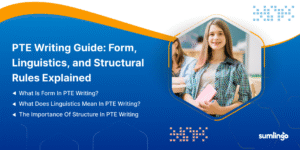The PTE (Pearson Test of English) exam can feel like a challenge, especially when it comes to the Speaking and Writing sections. One of the key factors that determines your score in these sections is Content. The Content score is crucial because it evaluates whether your ideas are relevant, well-developed, and clearly expressed. But don’t worry; the content score can be improved with some effective strategies, and it will maximize your score.
What Is Content in PTE Speaking and Writing?
Before we discuss strategies, let’s understand what content means in the context of the PTE exam.
- In speaking, content refers to how relevant, clear, and well-structured your spoken response is. It’s not just about speaking fluently but also about providing clear, appropriate information that answers the question fully.
- In Writing, content is about developing your ideas fully, organizing them logically, and staying on topic. Your response should include sufficient detail to support your argument or answer.
Are you ready to test your skills?
1. Stay Relevant and On-Topic
One of the most important factors for scoring well in content is ensuring that your response directly addresses the prompt.
- In speaking, you should focus on answering the question asked, without drifting into unrelated topics. For example, if the prompt asks for your opinion on a particular issue, make sure to provide clear reasons for your stance rather than giving a general opinion about the topic.
- In writing: Stay focused on the main question or topic throughout your essay. It’s easy to go off-track when writing essays, but if your ideas don’t directly address the prompt, your content score will suffer. Always keep the question in mind and ensure that your paragraphs support your main argument or idea.
2. Develop Your Ideas
Simply stating an opinion or making a claim isn’t enough. You need to develop your ideas by explaining them in detail and giving examples.
- In speaking: After stating your point, explain it clearly. For example, when you are asked to describe an image, it’s not enough to just give a general overview. You must focus on specific details from the image, explain what’s shown, and organize your thoughts logically.
- In Writing: Make sure each paragraph is fully developed. If you’re writing about a specific issue, explain why it’s important, provide examples, and offer a conclusion. A well-developed idea demonstrates depth and shows that you can think critically about the topic.
3. Organize Your Response Clearly
Clarity and organization are key to a high Content score. Your response should be easy to follow, with a clear structure.
- In speaking: a good structure will make your response sound more coherent. Start with a brief introduction, followed by key details, and conclude with a summary. For example:
- Introduction: Briefly introduce the topic.
- Main Points: Explain the key details.
- Conclusion: Summarize your thoughts.
- In Writing: Similarly, ensure that your essay has a clear structure. Use paragraphs to separate different ideas. The general structure should look like this:
- Introduction: Introduce the topic and outline your main argument.
- Body Paragraphs: Each paragraph should address one idea, supported by evidence or examples.
- Conclusion: Summarize your main points and freshly restate your argument.
4. Be Specific and Avoid Generalizations
General statements like Many people think or It is common knowledge often don’t add much value. Instead, focus on being specific in your answers.
- In Speaking: In the Re-tell Lecture task, you listen to a short lecture on a specific topic, and your job is to summarize the key points clearly and accurately in your own words. The goal is to focus on the main idea and important details presented during the lecture, without adding unnecessary information or your own opinions.
- In Writing: In your essays, avoid vague or broad statements. Instead of saying, The environment is important, explain why it’s important and how it impacts us, supporting your argument with facts or real-world examples.
5. Practice Answering the Prompt Fully
A common mistake is not fully answering the question. For example, in the PTE Writing section, you may be asked to agree or disagree with a statement and provide reasons for your choice. Sometimes, candidates only partially answer or give only one reason.
- In Speaking: The most important aspect of maximizing your content score is ensuring that your response is directly relevant to the prompt or task you’re given. Whether you’re describing an image, repeating a sentence, or summarizing a lecture, your answer must reflect the exact nature of the prompt.
- In Writing: Always ensure that your essay answers the question completely. If you’re asked to discuss both sides of an issue, do so and provide your opinion at the end. Providing a full, balanced answer will improve your Content score.
6. Use Clear and Simple Language
While it’s important to be specific and develop your ideas, it’s equally crucial to ensure that your response is easy to understand. Using overly complicated language or jargon can confuse the listener or reader and lower your content score.
- In Speaking: Speak clearly and avoid using complicated vocabulary unless it’s necessary to express your point. The goal is to communicate your ideas effectively.
- In Writing: Similarly, use straightforward language. Aim for clarity and conciseness, avoiding overly complex sentences that may make it harder to follow your argument.
7. Keep Practicing Regularly
Maximizing your Content score in PTE requires consistent practice. Regular speaking and writing practice will help you refine your ability to stay on topic, develop your ideas, and organize your responses.
- In Speaking: Practice with sample questions and try to answer them fully. Record your responses and listen for clarity, relevance, and detail.
- In Writing: Write essays on various topics, focusing on developing your ideas thoroughly. After writing, read through your essays and check if they answer the prompt completely and if the ideas are well-supported.
In Conclusion
Maximizing your Content score in PTE Speaking and Writing doesn’t have to be difficult. By staying relevant to the topic, developing your ideas with examples, and organizing your responses clearly, you’ll be on the path to achieving a higher score. Practice consistently and focus on delivering well-thought-out responses that fully address the prompt. With these strategies, you’ll improve your performance and boost your chances of success in the PTE exam.
Are you ready to test your skills?
Frequently Asked Questions (FAQs)
1. What does Content mean in PTE Speaking and Writing?
In PTE Speaking, Content refers to how relevant and clear your spoken response is. In Writing, it’s about developing your ideas fully and organizing them logically to address the prompt directly.
2. How can I stay on-topic in PTE Speaking?
You should focus on answering the question directly. Avoid veering off-topic or adding personal opinions that aren’t relevant to the task.
3. How can I avoid generalizations in my responses?
Test takers must be specific in their answers. Avoid vague phrases like many people think. Instead, provide concrete examples or data to back up your claims.
4. How can I improve my Content score with practice?
Regular practice is key. Students should focus on staying relevant, developing their ideas, and organizing their responses clearly. They should record your answers and review them to ensure clarity and completeness.
5. What’s the best way to organize my responses in PTE Speaking?
You should structure your response clearly: start with an introduction, follow with key details or main points, and end with a brief conclusion. This makes your response easy to follow and ensures you cover all relevant aspects of the task.










